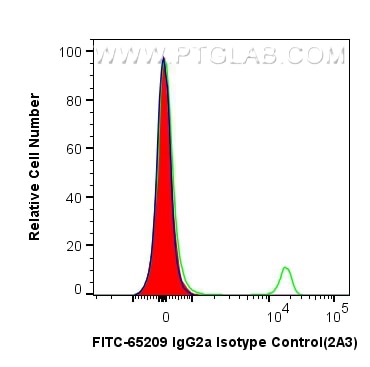Validation Data Gallery
Filter:
Tested Applications
| Positive FC detected in |
Recommended dilution
| Application | Dilution |
|---|---|
| Flow Cytometry (FC) | FC : 0.5 ug per 10^6 cells in 100 μl suspension |
| This reagent has been tested for flow cytometric analysis. It is recommended that this reagent should be titrated in each testing system to obtain optimal results. | |
| Sample-dependent, Check data in validation data gallery. | |
Published Applications
| FC | See 1 publications below |
Product Information
FITC-65209 targets IgG2a Isotype Control in FC applications and shows reactivity with n/a samples.
| Tested Reactivity | n/a |
| Host / Isotype | Rat / IgG2a, kappa |
| Class | Monoclonal |
| Type | Antibody |
| Immunogen | N/A 相同性解析による交差性が予測される生物種 |
| Full Name | IgG2a Isotype Control |
| Gene Symbol | |
| Gene ID (NCBI) | |
| RRID | AB_2883823 |
| Conjugate | FITC Plus Fluorescent Dye |
| Excitation/Emission maxima wavelengths | 495 nm / 524 nm |
| Form | Liquid |
| Purification Method | Affinity purification |
| Storage Buffer | PBS with 0.09% sodium azide{{ptg:BufferTemp}}7.3 |
| Storage Conditions | Store at 2-8°C. Avoid exposure to light. Stable for one year after shipment. |
Background Information
The 2A3 immunoglobulin is useful as an isotype-matched control. The 2A3 immunolglobulin binds to TNP (trinitrophenol), a hapten not expressed on mouse or human cells. It is used as an isotype control for rat IgG2a antibodies. This antibody has been quality-tested for flow cytometry as negative control.
Protocols
| Product Specific Protocols | |
|---|---|
| FC protocol for FITC Plus IgG2a Isotype Control antibody FITC-65209 | Download protocol |
| Standard Protocols | |
|---|---|
| Click here to view our Standard Protocols |
Publications
| Species | Application | Title |
|---|---|---|
Int Immunopharmacol Neutrophil PPIF exacerbates lung ischemia-reperfusion injury after lung transplantation by promoting calcium overload-induced neutrophil extracellular traps formation |
